Abstract
This article examines digital transformation and technology adoption within small and medium-sized enterprises (SMEs) in developing countries. It focuses on identifying the mechanisms that facilitate or hinder the integration of new technologies in these contexts, often constrained by specific socioeconomic and cultural factors. The research employed a systematic literature review, adhering to a structured protocol to explore existing studies. Critical stages of this review included defining research questions, developing a comprehensive search strategy, and systematically selecting and analyzing relevant studies from significant databases. The review reveals a significant emphasis on basic information systems as the primary form of technology adoption in SMEs within developing countries, with more advanced technologies like cloud computing and artificial intelligence being less common. Factors such as the entrepreneurial ecosystem and external social influences, including government and private sector initiatives, play pivotal roles in shaping these adoption patterns. This study underscores the critical role of community-driven efforts in promoting technology adoption over initiatives by the public and private sectors. The findings suggest a need for future research to develop tailored technological adoption models that accommodate the unique challenges of SMEs in developing countries. Additionally, more inclusive approaches that consider sociocultural dynamics could further enhance the effectiveness of technology integration strategies in these regions.
1. Introduction
The last decade has witnessed the rise of transformative technologies that have established themselves within the industrial sector, fueled by the exponential growth of Information and Communication Technologies (ICTs), alongside substantial investments from industries in deploying these technologies [1,2,3]. This synergy has propelled the digital transformation of industries [4], signifying a paradigm shift towards integrating digital technologies across all facets of human society [5,6]. Digital transformation is about enhancing existing methods and fostering innovation and creativity through digital applications in specific domains [7,8].
The imperative for digital transformation is becoming increasingly universal across various industry sectors. However, the path to achieving such transformation is complex [9,10,11]. For numerous companies, the challenge—and opportunity—lies in strategically adapting and augmenting their technology infrastructures and business processes to meet future demand [12]. Organizations that lag behind in embracing these transformations risk being outpaced by their more forward-thinking counterparts. Consequently, it is unsurprising that various stakeholders, including governments, are keen on encouraging small and medium-sized enterprises (SMEs) to adopt this progressive mindset [9,10,11].
The discourse on technology utilization and adoption is prolific, particularly on developing technology acceptance models [13,14,15,16,17,18]. These models, rooted in information systems theory, propose that several factors influence users’ acceptance and utilization of new technologies. Such models are crucial as they guide decision-making processes for supporting industry within nations.
However, there needs to be more validation and application of these models, which predominantly focus on large enterprises [16,19,20,21] or differ significantly across cultural contexts [22,23,24,25]. Research on SMEs in developing countries is scant and often needs to adequately adjust to their unique sociocultural landscapes [8,26,27,28,29,30]. Ignoring the sociocultural dimensions specific to each country can result in recommendations that may not be in touch with actual needs and contexts.
In digital transformation, it is essential to consider the sociocultural factors that inherently influence technology adoption and behavioral change. These factors include values, beliefs, social norms, and cultural practices, which vary significantly across countries and communities [31]. Thus, research must explore digital transformation with an approach that incorporates the unique sociocultural characteristics of each context, ensuring that content, recommendations, and priorities are specific to local attributes [31,32].
While extensive research has explored digital transformation and technology adoption, significant gaps in how these models apply to SMEs in developing countries still need to be discovered. The current literature predominantly targets large enterprises in developed regions, often overlooking the unique sociocultural, economic, and infrastructural challenges that SMEs in developing areas encounter. This disconnect results in strategies that may need to align better with local needs. Our study seeks to bridge this gap by thoroughly reviewing the existing literature, focusing specifically on adopting technology in developing countries’ SMEs. We aim to define key concepts clearly, explore the scope of digital transformation, identify the main drivers, and address critical barriers, thus tailoring our research to the unique landscapes of developing economies. By proposing a structured framework based on these insights, our article intends to fill crucial theoretical gaps and offer practical solutions, thereby enhancing the relevance and effectiveness of technology adoption models across diverse global settings, particularly in under-researched areas.
This paper is structured as follows: In Section 2, we describe the key concepts of the research’s theoretical framework and review related work. Section 3 describes the methods used for the systematic mapping of studies. Section 4 and Section 5 report the results and discuss them. Finally, Section 6 presents the conclusions and future directions.
2. Background
2.1. General Concepts
2.1.1. Digital Transformation and Technology Adoption
Digital transformation, as delineated in Cavalcanti’s meta-analyses [33], encompasses the enhancement of existing products through the integration of digitization and digital innovation resources [7]. This phenomenon is inherently multidisciplinary, affecting multiple facets of an organization, including strategy [34], workforce [35], technology [36], culture [37], and the broader social and organizational structures [38]. These elements collectively shape how businesses engage with their customers [39].
However, it is essential to recognize that the most critical aspect of digital transformation is the human element [33]. The rapid evolution of technology only becomes impactful when it is embraced and adopted by people [7]. According to Kane [40], individuals tend to adopt disruptive technologies more swiftly than organizations, which may require more time and a greater degree of flexibility to adjust. This highlights the necessity of exploring digital transformation from the perspective of individual adoption within organizations.
Digital transformation, as defined by Cavalcanti’s meta-analyses [33], involves enhancing existing products and services through the integration of digital technologies and innovative resources [7]. This multidisciplinary phenomenon impacts various organizational aspects such as strategy, workforce, technology infrastructure, cultural practices, and broader social and organizational structures [34,35,36,37,38,39] These elements determine how businesses interact with customers and adapt to rapidly changing markets.
The human element is central to the success of digital transformation; technology becomes impactful only when it is actively embraced and utilized by individuals within an organization [7,33]. Kane [40] notes that while individuals may quickly adapt to disruptive technologies, organizations often need more time and flexibility to integrate these changes effectively. This discrepancy underscores the importance of viewing digital transformation as both a goal and an ongoing process responsive to the target populations’ specific needs and conditions [41,42].
The concept of technology adoption is integral to this discussion. It focuses on how digital tools are not merely implemented but accepted and woven into the fabric of daily organizational activities. By studying technology adoption within the digital transformation framework, we can gain deeper insights into how digital technologies enhance organizational efficiency and outcomes. This approach helps to clarify the roles of individual and organizational acceptance in successfully integrating new technologies, thus addressing the specific characteristics and challenges that SMEs face in developing countries.
2.1.2. Cultural Behavior
Cultural factors are pivotal in shaping technology adoption within SMEs in developing countries. Cultural dimensions such as power distance, individualism versus collectivism, and uncertainty avoidance directly influence organizational decision-making processes, including adopting and implementing new technologies. For instance, a study in India highlighted how high power distance in traditional SMEs often results in centralized decision-making, which can slow the adoption of new technologies unless spearheaded by top-level management [43,44,45]. Similarly, in collectivist societies like those found in Southeast Asia, technology adoption decisions in SMEs are frequently influenced by the prevailing community norms and practices, where businesses might adopt new technologies if there is collective agreement on their perceived benefits [44].
Moreover, the role of trust and interpersonal relationships, which are core to many cultures in developing countries, cannot be underestimated. In regions such as Sub-Saharan Africa, where interpersonal trust is a significant cultural trait, SMEs are more likely to adopt technologies recommended by trusted network members or widely adopted within their business communities [46]. These cultural traits underscore the urgent need for technology providers and policymakers to consider cultural congruence when designing and promoting technology adoption strategies in these regions.
Additionally, resistance to change, a common cultural characteristic in many developing countries, can be mitigated by involving community leaders and influencers in the technology adoption process. This approach aligns new technological solutions with local values and practices, not only facilitating smoother technology integration but also leveraging cultural strength to enhance organizational and community buy-in [47].
By acknowledging and integrating these cultural factors, technology adoption models can be better tailored to the unique context of SMEs in developing countries. This ensures that the solutions proposed are both socially acceptable and effectively implemented. This culturally informed approach drives technology adoption and contributes to SMEs’ sustainable growth and development within these diverse cultural landscapes [48,49].
2.1.3. Developing Countries
Developing countries, identified as low- and middle-income nations, exhibit lower socioeconomic development levels than developed nations, marked by lower GDP per capita, minimal industrialization, limited technological infrastructure, and poorer living standards [50,51]. These nations face various challenges, including economic diversification deficits, high poverty rates, and underdeveloped health and education systems [52,53]. Digital transformation in these regions is necessary beyond technological upgrades; it is crucial for accelerating development by leapfrogging traditional industrialization stages, thus enhancing access to essential services such as healthcare, education, and finance.
The unique challenges, such as infrastructural deficits, varied regulatory environments, and diverse degrees of digital literacy, demand tailored interventions sensitive to local contexts. Moreover, effective integration into the global digital economy is crucial to prevent economic isolation and harness growth opportunities within global value chains. Sociocultural dynamics and governance structures significantly influence the adoption and effectiveness of technology solutions, which must be culturally resonant and widely accepted to ensure inclusivity. Digital transformation initiatives must address equity and inclusion issues to avoid widening the gap between different societal groups, aiming to benefit all segments, particularly the vulnerable. This focus on the particularities of developing countries aims to contribute to sustainable development practices that enhance life quality across these regions, ensuring that digital transformation efforts are inclusive and effectively address unique local challenges [31,54].
2.2. Related Works
This section aims to explore additional scholarly work that complements our analysis, mainly focusing on digital transformation initiatives within micro and small enterprises (MSEs) in developing countries. We aim to identify elements that can augment our research with practical solutions to bridge the technological gap affecting MSEs.
In the subsequent subsections, we highlight pertinent studies that align with our research goals. During our review, we identified 21 secondary studies addressing themes similar to our proposed research. Table 1 provides a concise summary of these articles, categorizing them into eight objectives based on the commonalities in their focus and methodology.

Table 1.
Related works’ topics.
The findings from these papers have been organized into three primary categories based on their core content and methodological approaches:
Adoption and Impact of Digital Technologies. This category examines the mechanisms through which small and medium-sized enterprises (SMEs) adopt and utilize digital technologies, including social networks, information and communication technology (ICT) readiness, social media marketing, blockchain, and artificial intelligence (AI). The studies within this cluster provide quantitative and qualitative analyses of how these technologies influence SMEs’ operational performances, efficiency, and strategic redirection. For instance, research within this domain often utilizes the diffusion of innovations theory to analyze the rate and factors influencing the uptake of new digital tools within organizational settings. The focus extends to evaluating digital initiatives’ return on investment (ROI) and their impact on market reach, customer engagement, and internal process efficiencies. This facet of digital transformation research aligns with the main article’s objective of highlighting actionable, evidence-based technology integration strategies specifically tailored to the needs and constraints of SMEs in developing regions.
Digital Transformation and Crisis Resilience. This grouping synthesizes findings from studies focused on the role of digital transformation in enhancing organizational resilience to external shocks, such as the COVID-19 pandemic, and adapting to the technological imperatives of the Fourth Industrial Revolution. It includes comprehensive reviews of how digitized processes have enabled SMEs to maintain continuity amid disruptions by leveraging digital platforms for remote work, e-commerce, and digital customer service channels. This cluster also discusses the strategic integration of digital Corporate Social Responsibility (CSR) initiatives that align with broader societal and environmental goals during crises. This emphasis on the potential of digital transformation to inspire aligns with the main article’s discussion on constructing robust business models secured against current and future challenges.
Innovation, Sustainability, and Competitiveness. This category delves into the advanced intersections of digitalization with sustainability initiatives and competitive market positioning. It covers empirical and theoretical studies on the implementation of cutting-edge data science techniques, adoption of Lean–Green practices, assessment of digital maturity models, integration of business information systems (BISs), and the potential of next-generation 5G technologies. These studies typically employ frameworks like the triple bottom line (TBL) to evaluate how digital innovations contribute to economic, social, and environmental sustainability goals. The research highlights the transformative potential of digital tools for optimizing resource use, enhancing supply chain efficiencies, and enabling sustainable business practices that lead to improved competitive advantages in international markets. This optimistic view of the future aligns with the main article’s focus on how digital transformation can drive not only operational efficiency and market growth but also broader societal benefits, thus reinforcing the critical role of innovation in achieving sustainable development in emerging economies.
The thematic clusters identified in this review collectively underscore the multifaceted nature of digital transformation and its pervasive impact across various dimensions of SMEs in developing countries. By dissecting the intricacies of digital technology adoption, the resilience fostered through digital capabilities during crises, and the innovation that drives sustainability and competitive advantage, this review highlights not only the current state of research but also the critical roles that these elements play in the overarching economic development of these regions. Notably, while these clusters provide a comprehensive understanding of the landscape, they also reveal a significant gap in the development of robust theoretical models that integrate these diverse aspects into a cohesive framework for digital transformation. This gap represents a crucial opportunity for future research to develop more holistic models that encompass technological advancements and address the socioeconomic and cultural contexts of SMEs in developing economies. Such advancements will enrich the academic discourse and provide practical frameworks that can guide effective policy-making and strategic business decisions in these vital sectors.
3. Methods
Systematic Mapping Studies (SMSs) represent a structured methodology within software engineering research, adhering to the rigorous protocols outlined by Petersen et al. in [75]. This approach was specifically chosen for its robustness in dealing with broad research questions by mapping out large fields of study to identify trends in, gaps in, and clusters of research activity. It is particularly suited to exploring emerging fields like digital transformation in developing countries, where it is crucial to understand the wide array of interdisciplinary literature and findings.
The validity of the SMS methodology is well supported in the literature, as Petersen et al. [75] provide empirical evidence demonstrating its efficacy in comprehensively categorizing and synthesizing research across various domains. Furthermore, the method’s credibility is enhanced by its widespread acceptance and application in numerous high-impact studies, which have successfully utilized SMSs to inform future research trajectories and policy directions.
The methodological frameworks of SMSs facilitate a thorough categorization and analysis of the existing literature on a designated topic or research area. They are instrumental in delineating this study’s scope and synthesizing the accumulated knowledge. The execution of an SMS necessitates the meticulous application of predefined stages, as illustrated in Figure 1. Each stage is contingent upon the successful completion of its predecessor, ensuring a systematic progression that yields tangible outputs. These outputs, in turn, form the foundational input for subsequent stages, thereby facilitating a coherent and cumulative research development process.

Figure 1.
Stages of the systematic mapping process.
To ensure the rigor and relevance of our study, the selection and analysis criteria were meticulously established based on a combination of methodological guidelines suggested by Petersen et al. [75] and adaptations necessary to address the unique aspects of our research focus. The research questions were derived through an iterative process that involved an initial literature survey to identify key themes and knowledge gaps, followed by consultation with domain experts to refine these questions to ensure that they effectively capture the essence of digital transformation challenges in developing countries.
The SMS approach is particularly valuable in examining digital transformation or technology adoption within the micro and small economies of developing countries. By applying this structured approach, we aim to provide a nuanced understanding of how digital innovations are assimilated and leveraged in these economies, contributing to a more informed and targeted research agenda.
3.1. Definition of Research Questions
The initial phase involved outlining the research questions (RQs), which provide the foundational methodology for the subsequent stages of the process. Table 2 enumerates the four RQs pertinent to this study; Figure 2 shows the study areas for the RQs: (a) Digital Transformation Evaluation Models for SMEs, (b) Sociocultural Behavior, and (c) Drivers and Barriers for SMEs. The intersection of the elements is represented in (d).

Table 2.
Research Questions.
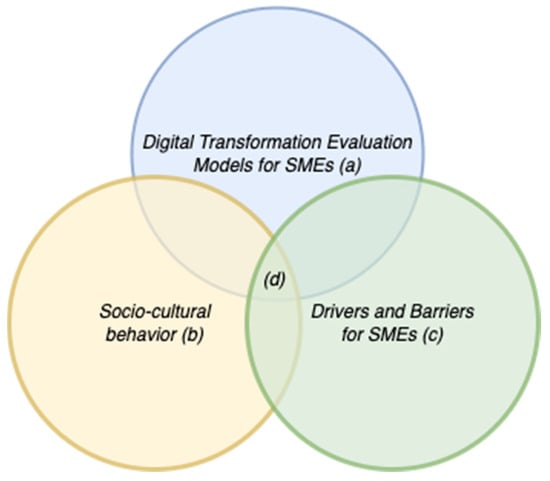
Figure 2.
Study areas.
3.2. Conduct Search
Based on the research questions introduced earlier, we formulated the search string to specify the domain of the topic, associated terms, and the incremental development of the partial string that culminates in the final search string. The search string’s methodology was grounded in the PICOC criteria guidelines (see Table 3) [76,77].

Table 3.
PICOC criteria.
Table 4 provides a detailed account of the search string’s construction. Each set of analogous terms is connected using the “OR” operator, while different domains are combined with the “AND” operator. It is essential to recognize that the search string may undergo minor adjustments based on the specific search engine utilized. Nonetheless, these variations did not impact the outcomes of this study.

Table 4.
Keywords and synonyms.
Given the combination of needs and specifications, the resulting search chain was as shown in Table 5.

Table 5.
Research chain.
3.3. Sources of Analysis
The databases used for searching included ACM, IEEE DL, WOS, Scopus, and Wiley (see Table 6). We present a summary of these results in Figure 3.

Table 6.
Sources.
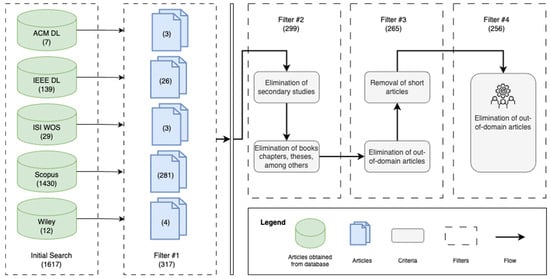
Figure 3.
Article filtering stages.
3.4. Article Selection Process
The selection of articles involved applying inclusion and exclusion criteria to the outputs from each search engine, as depicted in Table 7. Inclusion criteria targeted articles presenting proposals, strategies, tools, experiments, methodologies, devices, and/or models that improve the digital transformation of technology adoption. Conversely, the exclusion criteria filtered out publications unrelated to technology or engineering in conventional settings, as well as literature reviews. The time frame for consideration was set from 2018 to 2023. This decision was mainly made for two reasons. First, we wanted to limit the number of results obtained in the first iterations, which increased exponentially as more years were incorporated. Second, we sought to identify new trends and collections, considering that the concepts of technology and basic needs are changing rapidly.

Table 7.
Selection criteria.
The research papers were initially sifted through based on titles, abstracts, and keywords using the inclusion criteria, ensuring the identification of the most relevant contributions to the field. This step was followed by the application of the specified time range and the removal of duplicates.
Subsequent screening involved the application of exclusion criteria to the abstracts, discarding short articles (less than 3 pages), theses, technical reports, and tutorials. Only those studies focusing on technology adoption and digital transformation in developing countries were retained. An exhaustive review of the remaining documents ensued, culminating in an independent blind vote by each author to determine the final selection. The consensus among researchers was quantitatively assessed using Fleiss’ Kappa index, as introduced by Gwet [78], which indicated a reliability rate of 62.3%. This measure was used to evaluate the level of agreement between raters beyond what would be expected by chance. It is particularly useful in situations where decisions are subjective and it is essential to assess the consistency of these decisions across different evaluators. Each author independently rated the same set of articles according to specific criterion. The Kappa value was then computed by comparing the agreement observed among the raters to the agreement that could be expected by chance alone.
The criteria previously outlined resulted in the creation of filters to organize and apply these criteria in a step-by-step and progressive style. Table 8 outlines the particulars of each filter.

Table 8.
Details of applied filters.
3.5. Quality Assessment
To determine the quality of primary studies and select articles that contribute significantly to this research, we implemented criteria to guarantee a baseline quality level. Articles were assessed using a checklist marked with ‘Y’ (value = 1) for yes and ‘N’ (value = 0) for no. Accordingly, we established four quality assessment criteria used by the reviewers throughout the evaluation process:
- QC1: The article articulates a specific research goal and provides a thorough contextual description;
- QC2: The article specifies the research methodology employed to meet the research goal;
- QC3: The article employs a methodology that is both clear and suitable for this study’s objective;
- QC4: The article delivers findings relevant to digital transformation or the practical implementation of technology adoption.
3.6. Data Extraction
For the data extraction process to be rigorous and facilitate the management of the extracted data, a classification scheme was designed, which is shown in Figure 4.

Figure 4.
Classification scheme for the literature review.
All the categories related to the area technology adoption methods emerged from the TOE proposal of Tornatzky [79]. This classification considers the edges of technology, organization, and environment, in addition to the statement of the location of each exercise. In addition, the theoretical models of technological adoption used and the types of contribution, drivers, and barriers are detailed.
3.7. Study Support Files
To facilitate replication and validation of our research, we make available the full dataset utilized for our analyses. The repository includes a list of the base articles for the construction of this document, as well as high-resolution images of their analysis (see Supplementary Materials).
4. Results
4.1. Context and Research Approach
4.1.1. Publication Years
Figure 5 illustrates the distribution of documents by year based on the data extracted from the provided dataset. Most documents were published recently, indicating a growing interest or increasing research activity in the related field. Notably, 2021 and 2022 have more publications than in earlier years, suggesting a surge in studies or developments during this period. This trend could be attributed to advancements in technology, changes in industry standards, or emerging challenges that have captured the attention of researchers and professionals. The visualization helps us to understand the temporal dynamics of the publication activity, highlighting periods of heightened interest and research within the dataset’s context.

Figure 5.
Evolution of the subject—entries per year at articles and conferences.
4.1.2. Data Sources
Drawing from the five databases (ACM Digital Library, IEEE Digital Library, ISI Web of Science, Scopus, Wiley), our initial search produced 1617 papers. Most of these papers were sourced from Scopus and the IEEE Digital Library. Implementing the first and second filters resulted in a substantial decrease of 81.51% in the total number of articles.
Furthermore, the employment of the third and fourth filters and their specific criteria led to an additional reduction of 84.17% from the initial number of articles retrieved, culminating in a final selection of 256 articles. Notably, after the application of the fourth filter, only articles from the ACM Digital Library (2), the IEEE Digital Library (17), ISI Web of Science (1), and Scopus (236) remained included in this study (refer to Table 9).

Table 9.
Distribution of results by data source.
4.1.3. Type of Study and Contribution
Figure 6 illustrates the distribution of sociocultural objectives across different geographical regions in our dataset. Most of the entries are focused on Asia, with a count of 178, indicating a significant emphasis on sociocultural goals within this region. Africa follows with 29 entries, showcasing moderate activity, while Europe has 22 entries. Both South America and Oceania are represented with lower frequencies, with 15 and 12 entries, respectively, pointing to a lesser focus on these areas in the dataset. This distribution highlights a predominant interest in Asian sociocultural objectives within the scope of the data analyzed, suggesting a possible area of concentration for future studies or initiatives aimed at understanding or influencing sociocultural trends.
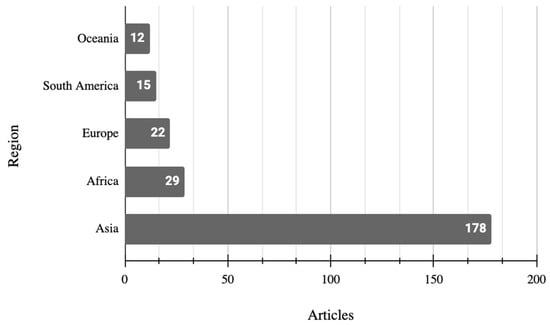
Figure 6.
The number of items obtained by region.
Figure 7 provides a clear visual representation of the prevalence of various technological initiatives within our dataset, encompassing a range of categories such as the cloud, data analysis tools, information systems, marketing tools, artificial intelligence, and the Internet of Things (IoT). Most articles incorporate these technologies, with cloud and artificial intelligence tools being notably prominent. This highlights a strong trend towards leveraging advanced technological solutions to address complex challenges and optimize various processes. The significant number of tools in these categories underscores the increasing reliance on technology across different sectors and its critical role in driving innovation and efficiency. Each category represents a key area where technology is applied to enhance capabilities, streamline operations, and offer new insights, demonstrating technology’s diverse applications and impacts on contemporary research and industry practices.
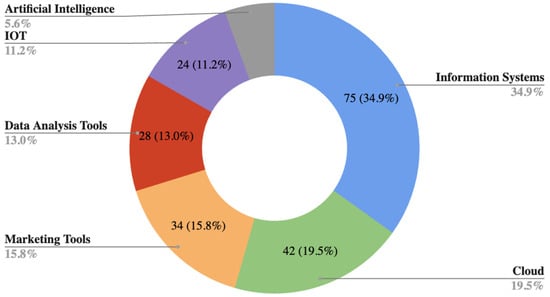
Figure 7.
Evaluation of the technology dimension.
Figure 8 presents two bars representing the organizational dimensions of “Innovation” and “Process Improvements”. The bar for “Innovation” shows a value of 133, accounting for 46.18% of the dataset, while “Process Improvements” is represented with a value of 155, making up 53.82% of the data. This illustrates that process improvement initiatives are marginally more prevalent than innovation initiatives in the analyzed dataset. Innovation, here, pertains to adopting new ideas, products, services, or practices within an organization that aim to enhance outcomes, efficiency, or performance. In contrast, process improvement is dedicated to enhancing the efficiency and quality of existing procedures through incremental enhancements, focusing on reducing costs, improving quality, and speeding up delivery times rather than implementing sweeping changes.
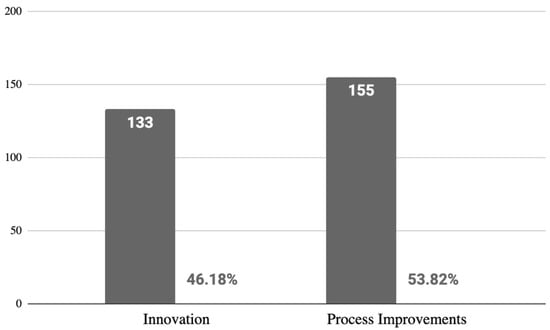
Figure 8.
Evaluation of the organizational dimension.
Figure 9 displays four bars, each representing a different evaluation of environment dimension elements. The bars illustrate the following components:
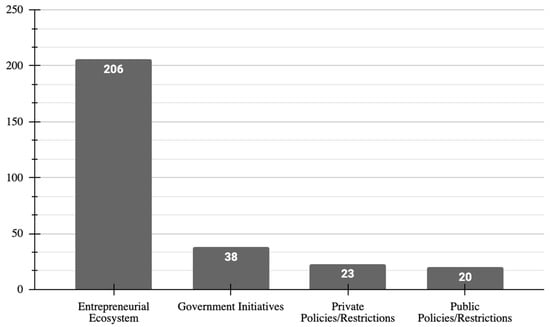
Figure 9.
Evaluation of the environmental dimension.
- Entrepreneurial Ecosystem: This refers to the network and conditions that facilitate entrepreneurship, including access to capital, mentorship, and a supportive community;
- Government Initiatives: These are programs or policies implemented by the government to encourage business activity, such as tax incentives, grants, or regulatory reforms;
- Private Policies: These consist of rules or guidelines set by private entities that influence their operations and the broader business environment, such as corporate governance standards or ethical sourcing requirements;
- Public Policies: These involve regulations and laws established by governmental bodies that dictate how businesses must operate, covering aspects like labor laws, environmental regulations, and compliance requirements.
The results highlighted in the figure show that the entrepreneurial ecosystem is the most prominent aspect, with a notably higher value than the other evaluated areas. This prominence suggests that the studied environment possesses a robust support system for entrepreneurship and innovation, with ample resources available to nurture new businesses and entrepreneurs. The considerable disparity between the value of the entrepreneurial ecosystem and those of Government Initiatives, as well as Private and Public Sector Policies, indicates that while there are meaningful efforts from both the public and private sectors to shape or bolster the business environment, these efforts pale in comparison to the vibrant activity within the entrepreneurial ecosystem itself. This dynamic might point to a predominantly entrepreneur-driven growth model within the environment under study.
Figure 10 illustrates that theoretical models, accounting for 51.1% of the research, are predominant in the studies reviewed. These models offer theoretical or conceptual frameworks that aid in understanding, organizing, and structuring knowledge domains. They are essential for elucidating complex phenomena and forecasting future trends in digital transformation.
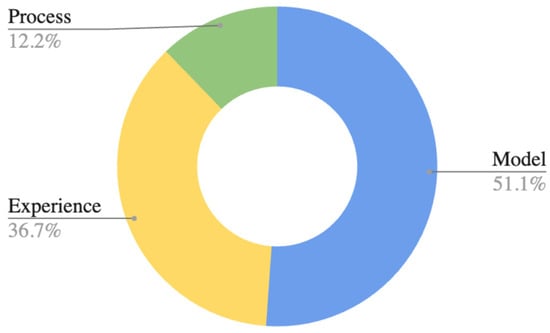
Figure 10.
Contribution type.
Experiences, representing 36.7% of the content, encompass practical insights and lessons learned through real-world application in various contexts. This category includes case studies and best practices vital for translating theoretical models into actionable strategies across diverse settings.
Contributions focusing on processes, which constitute only 12.2%, suggest that enhancing methodologies and optimizing workflows are relatively underexplored areas within the field. This lack of focus highlights a significant opportunity for future research that could profoundly improve the efficiency and effectiveness of technological implementations.
The data from the chart indicate a strong preference for developing theoretical models and a robust interest in practical applications, while process optimization receives comparatively less attention. This trend underscores the importance of a more integrated approach in research that equally emphasizes the refinement of operational methodologies alongside theoretical and practical advancements to foster more effective digital transformation strategies.
5. Discussion
5.1. Bibliometric Analysis
We conducted a detailed bibliometric analysis of the papers selected for this study to gain insights into the key terms, authors, and their inter-relationships within the field. Figure 11 provides an initial visualization of the thematic scope of these papers through a weighted word cloud. This word cloud was generated using the titles of the selected papers and highlights the fifty most relevant terms. The terms that featured prominently in the cloud, such as “technology adoption”, “digital transformation”, “enterprises”, and “SMEs”, closely align with the central themes of our study, confirming the relevance and focus of our bibliographic selection.
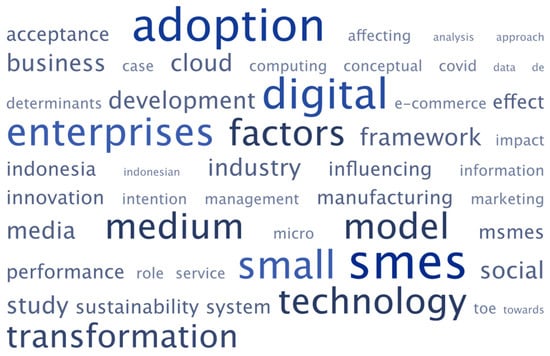
Figure 11.
Weighted word cloud from titles of selected articles.
Additionally, key concepts were extracted from the titles of the selected papers using a web service known as Termine, which is accessible via the academic domain of the University of Manchester. This service employs the C-/NC-value method to identify significant terms [80]. From this process, 153 relevant terms were identified. For illustrative purposes, Table 10 displays the top 40 terms, ranked by their relevance (score) in descending order. The bibliographic analysis, leveraging keywords and identified terms, highlighted topics predominantly related to technology adoption and digital transformation initiatives.

Table 10.
Weighted concepts extracted from the titles of the selected articles.
The outcomes affirm the appropriateness of the papers selected for our study. Following this, Figure 12 and Figure 13 illustrate two visual maps that detail the most significant terms and authors, respectively. These maps were created using the VOSviewer tool (version 1.6.20).
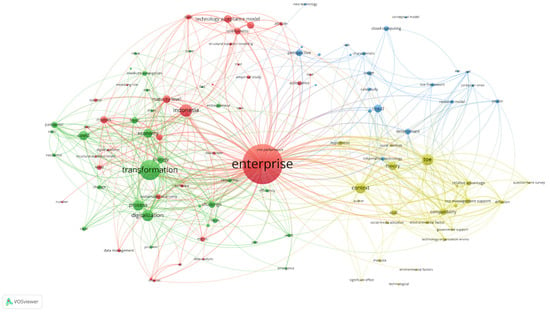
Figure 12.
The relationships between the most relevant terms.
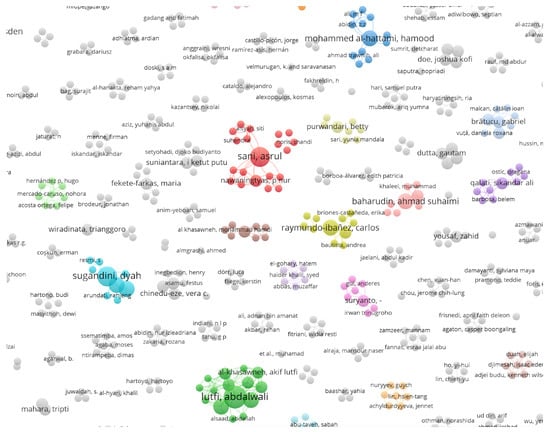
Figure 13.
The most relevant authors and their relationships.
The visualization presented in Figure 12 (see Supplementary Materials for full resolution) illustrates an intricate network of concepts pivotal to enterprise transformation initiatives. At the heart of this network is the nodal concept of “enterprise”, which connects to a myriad of related sub-topics. Different clusters radiate from this central node, each distinguished by color and representing interconnected domains. These include technological advancements (e.g., “new technology”, “cloud computing”), strategic frameworks (“competitive model”, “structural equation modeling”), organizational attributes (“medium enterprises”, “pandemic response”), and key drivers of transformation (“digitalization”, “sustainability”).
The node sizes denote the frequency and significance of the terms within the corpus of the analyzed literature, providing insight into the weight of each concept in academic dialogue. The lines weaving through the network highlight the relationships between terms, painting a complex picture of how these concepts interact within enterprise transformation. Notably, the “enterprise” node is robustly connected to fundamental concepts such as “transformation”, “information technology”, “theory”, “context”, and “cost”, reflecting their essential influence on enterprise evolution.
This network analysis charts the primary elements of enterprise transformation and signals how these elements coalesce to form the broader narrative of digital evolution within organizations. It offers a strategic vantage point for academics and practitioners alike, guiding the exploration of how enterprises can navigate and leverage digital transformation effectively.
Figure 13 (see Supplementary Materials for full resolution) depicts the interconnections among the top 100 authors contributing to digital transformation for small and medium-sized enterprises in developing countries. The diameter of each circle represents the number of publications attributed to each author, while the color gradient maps the temporal progression of their collaborative efforts. Clusters within the diagram indicate groups of authors who frequently collaborate, highlighting the collaborative networks within this academic domain.
5.2. Interpreting Answers to Research Questions
5.2.1. RQ1: What Are the Digital Transformation Models That Allow Evaluating Technological Adoption in Micro and Small Companies?
The literature provides various theories that explore the key factors influencing technology adoption within corporate settings. Each theory has its specific nuances, as comprehensively summarized by Rahayu et al. [81], which we utilize to expand our discussion. Figure 14 illustrates the different technology adoption models employed in our research.
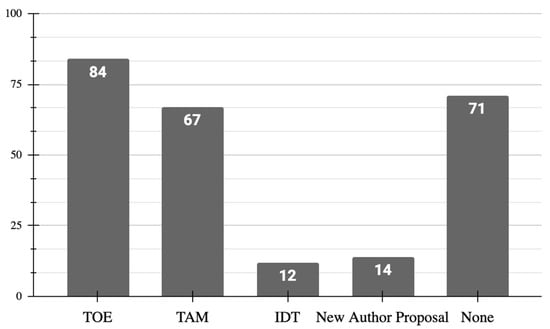
Figure 14.
A summary of the principal evaluation models.
Davis introduced the technology acceptance model (TAM) [82], designed to explain individuals’ behavior towards computer usage. In TAM, current behavior is influenced by “behavioral intention”, which is shaped by attitude and perceived usefulness. Additionally, perceived usefulness, together with ease of use, impacts attitude. Despite its applications, the model has its critics, such as El-Gohary [83], who argues that TAM overlooks the influence of both internal and external organizational factors [81].
While earlier theories predominantly adopt an individual-focused perspective, the Innovation Diffusion Theory (IDT) offers a process-oriented view detailing how innovations are adopted and integrated within communities [84]. Developed by Rogers [85], IDT draws extensively on psychological and sociological theories and considers relative advantage, compatibility, complexity, trialability, and observability as determinants of the adoption rate [81].
Another significant model is the Technology–Organization–Environment (TOE) framework developed by Tornatzky, Fleischer, and Chakrabarti [79]. This framework examines the impact of contextual factors on innovation adoption, recognizing not just the technological but also the organizational and environmental contexts. Unlike IDT, which focuses solely on technological aspects, TOE adopts an interactive perspective. It assumes that group differences are shaped by individual members and organizational characteristics [43]. The interactive approach of the TOE framework allows researchers to consider all factors and their interplay within a comprehensive framework [86], making it suitable for explaining IT innovation adoption [81]. According to TOE, three company aspects influence technological innovation adoption: technological, organizational, and environmental contexts. The technological context includes the internal and external technologies crucial to the company; the organizational context outlines the company’s structure and resources, influenced by size, decentralization, formalization, and management complexity; and the environmental context refers to external forces like competitors, suppliers, and governmental regulations [13,81].
Given the characteristics of the models that evaluate technological adoption processes, the number in the review of articles is consistent with their popularity. The TOE framework stands out [79], with 33.87% of the total, recognized for being part of the latest iterations of this type of model. In second place, with 27.02%, comes TAM [82], followed by IDT [85] (with 4.84%).
Notably, 5.65% of the proposals develop a particular or proprietary method to evaluate some dimensions particular to the target context (see Table 11).

Table 11.
Articles with original proposals by authors on technology adoption models.
5.2.2. RQ2: What Are the Mechanisms for Assessing Cultural Behavior in Micro and Small Enterprises?
Of the entire universe of articles reviewed, only 14 mentioned cultural behavior in some way. Table 12 shows those articles that mention “cultural” OR “culture” in their metadata.

Table 12.
Articles with a “cultural approach” on technology adoption models.
Table 12 presents an overview of the reviewed articles, including the article title, author-provided keywords, information on whether the article proposes a behavioral model or an approach to correlate different constructs, and whether the authors explicitly reference cultural behavior. The table is structured as follows: (i) Article Title—this column lists the titles of the articles reviewed. (ii) Author Keywords—this column displays the keywords provided by the authors to represent the main topics or concepts covered in their article. (iii) Behavioral Model/Construct Correlation—this column indicates whether the article proposes a behavioral model or presents an initiative that can correlate different constructs, regardless of their specific orientations or domains. (iv) Cultural Behavior Reference—this column highlights whether the authors explicitly refer to or address cultural behavior within the context of their study or proposal.
We must state that none of the articles highlighted in Table 10 has, as its basis, a standard cultural assessment model, as proposed by Hofstede [31,45,114]. That is to say, although some researchers are aware of this characteristic, they do not consider it in any scenario.
Based on the previous articles, organizational culture refers to the collective values, beliefs, principles, ways of working, historical values, and technological and governance structures within an organization [100,101]. It encompasses how people work and interact within the company. The authors highlight organizational culture’s importance in digital transformation (DT) for several reasons. Organizational culture can determine a company’s fate in the DT journey. It affects employee commitment to change, enables crucial dynamic capabilities to deal with DT, and is a key driver of organizational change. Organizations that have internalized the need to reconsider internal values according to new demands tend to be more comfortable achieving changes. The ability of a firm to innovate its business model depends on their workforce’s collective organizational values [108,109,110].
Specific cultural aspects like experiment orientation, customer-centered thinking, and cultivating an open and creative mindset are essential to support DT. Values and political guidelines impact the success of the process. In some digitally mature organizations, a particular “digital awareness” mentality contributes to DT’s success. It involves a positive attitude towards new technologies, trust in technology, and a focus on digital prioritization. This mentality supports rethinking competitive advantage. An entrepreneurial spirit and change-oriented disposition among employees provides the energy for constant evolution in digital organizations. Promoting this at employee and management levels enables the capacity to transform. In summary, the authors argue that organizational culture, through its values, mindsets, and ways of working, is crucial in enabling or hindering an organization’s ability to navigate the changes and innovations required for digital transformation successfully. The right culture is a crucial success factor [21,111].
In the work of Patrick and Hee [113], the authors consider a more holistic version of cultural behavior. The article investigates the influence of developmental culture, a dimension of organizational culture characterized by change, risk-taking, and innovation, on the intention to use affiliate marketing among small and medium-sized enterprises (SMEs) in Malaysia. Developmental culture is introduced as a moderating variable in the research model, drawing from the Competing Values Framework. It is defined as an ad hoc culture focusing on external opportunities, creativity, and flexibility, enabling firms to identify and acquire external knowledge effectively.
The findings reveal that developmental culture plays a moderating role in two relationships within the model. When developmental culture is low, it enhances the relationship between perceived usefulness and the intention to use affiliate marketing. Conversely, when developmental culture is high, it strengthens the relationship between compatibility and the intention to use affiliate marketing. The authors argue that a high developmental culture creates an environment conducive to adopting new technologies like affiliate marketing among SMEs. This study highlights the importance of considering organizational culture, particularly the developmental culture dimension, in understanding the adoption of innovations and new technologies within the SME context.
5.2.3. RQ3: What Are the Technological Barriers Affecting MSEs in Developing Countries?
Figure 15 illustrates the prevalence of various barriers to technological adoption faced by MSEs. Below is an improved interpretation and recommendation based on the data presented.
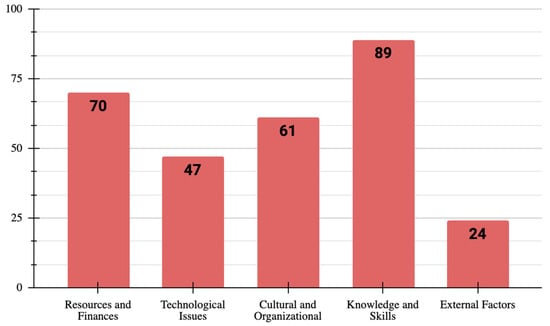
Figure 15.
Principal barrier.
Knowledge and Skills (30.58%): This category is the most significant barrier, highlighting a substantial gap in digital literacy and technical skills among MSEs. The deficiency in ICT training and education is prominent, underscoring the critical need for comprehensive educational programs tailored to enhance digital competencies within MSEs.
Resources and Finances (24.05%): Financial limitations are a significant impediment, as MSEs frequently need help to secure the necessary capital for technological investments. Developing accessible financing options and supportive fiscal policies is imperative to help these enterprises embrace and sustain modern technologies.
Cultural and Organizational (20.96%): Organizational resistance to change and a lack of management support are significant obstacles to technological advancement. Cultivating a corporate culture that prioritizes digital transformation and aligns technology adoption with strategic business goals could help MSEs to address these challenges.
Technological Issues (16.15%): Challenges such as the complexity and compatibility of new technologies with existing systems are prevalent. There is a pressing need for affordable and compatible technology solutions that integrate with MSEs’ existing infrastructures.
External Factors (8.25%): Issues like inadequate governmental policies and insufficient public infrastructure also pose significant constraints. Advocating for more effective public policies and promoting public–private partnerships are essential steps to enhance the technological readiness of MSEs.
A holistic strategy is essential to effectively address these barriers. This approach should integrate enhancements in educational offerings, financial support, organizational cultural shifts, suitable technological solutions, and governmental support. Such a comprehensive strategy would empower MSEs in developing countries to navigate the hurdles of technological adoption, enabling them to compete more effectively in the digital economy. The insights derived from our analysis should serve as a foundation for policymakers and relevant stakeholders to craft targeted interventions to bolster the digital resilience of MSEs.
5.2.4. RQ4: What Are the Determining Factors and Drivers in the Digital Transformation Process for MSEs in Developing Countries?
Figure 16 summarizes the main drivers of our study context that promote technological adoption processes. According to the classification scheme, these drivers can be divided into four distinct areas.
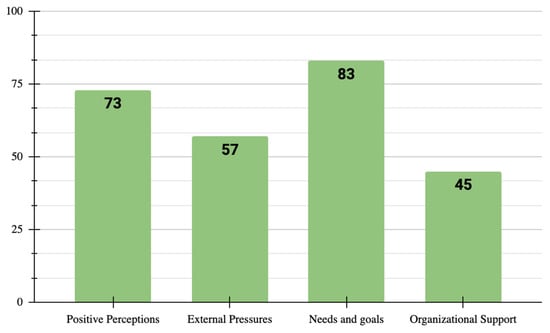
Figure 16.
Principal drivers.
The ‘Needs and Goals’ dimension, the most influential driver with 32.17% of the total articles, underscores the internal drive within companies to adopt new technologies. This driver, perceived as a medium- or short-term objective, is a powerful force even if the complexities of implementation are not fully understood. Its significance lies in its potential impact on the business.
The second most important driver is ‘Positive Perceptions’ (28.29%). This dimension encompasses the value that decision-makers recognize in the direct benefits of incorporating technology into their business operations. For example, they may perceive that technology can enhance efficiency, reduce costs, or improve customer satisfaction.
‘External Pressures’ (22.09%) ranks third among the drivers. This dimension relates to the competitive pressure exerted by direct competitors who have already adopted similar technologies and government regulations or obligations that may mandate technology adoption. For instance, if a major competitor implements a new technology and gains a significant market advantage, it may compel other companies to follow suit to remain competitive.
Finally, ‘Organizational Support’ has the lowest score, representing 17.44%, indicating that it has the most minor influence on technology adoption among the four drivers. This dimension pertains to the internal support and resources available within the organization to facilitate technology adoption. However, this aspect requires careful consideration, particularly in micro and small enterprises. These businesses often need more personnel, and the decision-maker is frequently the owner, which can impact the level and nature of organizational support available for technology adoption initiatives.
5.3. Orthogonal Discussion
Figure 17 provides a visual representation of the relationships between the categories outlined in our initial classification scheme (refer to Figure 4). The primary objective of this figure is to elucidate the interconnectedness of different dimensions within the context of digital transformation.
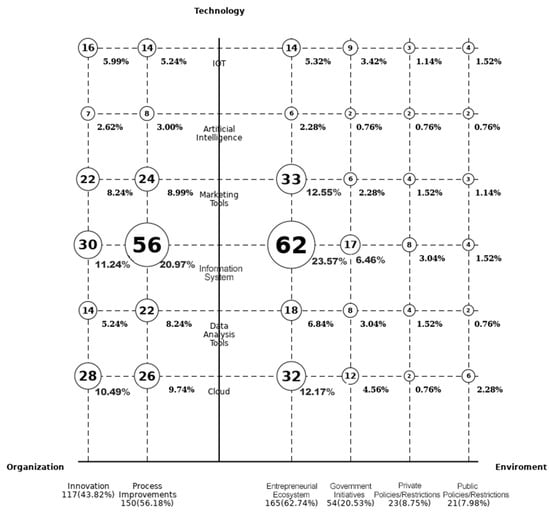
Figure 17.
The distribution of studies by Organization, environment, and technology.
Organizational Dimension: Positioned on the left side of the x-axis, the “Organization” dimension encompasses innovation and process improvement. These categories underscore organizations’ internal efforts to innovate and optimize processes in response to technological advancements.
In developing countries, digital transformation is primarily about integrating basic information systems, which represent nearly 33% of the total initiatives analyzed. However, there are lower rates of adoption for more advanced technologies such as cloud services, marketing tools, and basic data analysis tools like Excel spreadsheets. Interestingly, there is emerging engagement with even more advanced technologies like IoT devices and artificial intelligence, albeit at a relatively lower frequency (approximately 16% of the total initiatives). This suggests a gradual progression towards adopting more sophisticated technologies, possibly constrained by limited familiarity and infrastructure challenges.
Environmental Dimension: The “Environment” classification reveals a significant influence from the entrepreneurial ecosystem, constituting 62.74% of the total technological implementations. This ecosystem encompasses networks and conditions that support entrepreneurship, including access to capital, mentorship, and a supportive community. Government Initiatives, while present, account for a smaller proportion (20.53%) of technological implementations. This highlights the pivotal role of community-driven efforts in fostering technological adoption, overshadowing formal governmental interventions.
Despite the prevalence of basic digital transformation initiatives focused on information systems and rudimentary tools, it is the community-driven efforts spearheaded by the entrepreneurial ecosystem that play a central role in driving technological adoption in developing countries. While public and private sector initiatives contribute, their impact is comparatively smaller. This reiterates the importance of fostering a supportive community ecosystem to accelerate digital transformation efforts and address technological barriers effectively.
In summary, the findings suggest that while basic digital transformation proposals are expected, community-driven initiatives significantly drive technological adoption, underscoring the need for collaborative approaches involving both the public and private sectors to foster a conducive environment for digital innovation and growth in developing countries.
Figure 18 shows the distribution of articles across different dimensions, including barriers, drivers, and their contribution type. Focusing on the barriers, “Knowledge and Skills” is the most prominent barrier, present in 31.4% of the total articles. This suggests that a lack of knowledge and technical skills is the most commonly identified obstacle in the studies. These deficiencies are primarily determined using classic methodologies evaluated through technology adoption models, with notable ones being TAM [82], IDT [85], and TOE [79]. Articles that contribute by identifying “Experiences” account for 38.19% of all the articles assessing barriers.
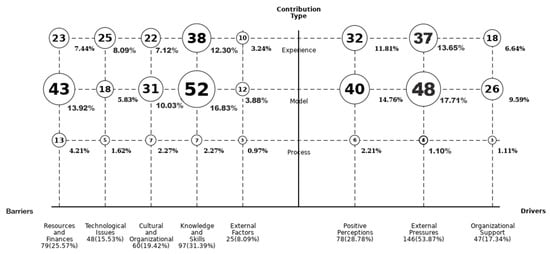
Figure 18.
The distribution of studies by barriers, drivers, and contribution type.
Shifting to the drivers, “External Pressures” (32.46%) and “Positive Perceptions” (28.78%) emerge as the top two factors propelling adoption. Interestingly, these drivers are also evaluated and identified using the same approach as the barriers—employing technology adoption models.
5.4. Threats to Validity
This section discusses potential limitations and their mitigation strategies:
- Study Search. To minimize search-related threats, we employed a predefined search string across major electronic databases. Prior to the actual search, a pilot search was conducted on each selected database to verify the accuracy and effectiveness of the search string.
- Study Selection Bias. We mitigated selection bias by using clearly defined inclusion and exclusion criteria. Additionally, several reviewers cross-checked all selected studies to ensure consistency. The inter-rater reliability, as measured by the Kappa coefficient, was 0.62, indicating substantial agreement among reviewers, thus significantly reducing the risk of discrepancies in study relevance.
- Data Extraction Bias. A systematic approach was used to ensure data extraction accuracy and reduce potential biases. Initially, one author developed a tool for distributing study results. Subsequently, five authors independently extracted data from an equal number of studies using a standardized form. Regular discussions between these authors helped to maintain consistency and mitigate data extraction bias.
Validity concerns the following:
- External Validity: External validity concerns the generalizability of the findings. The primary limitation is whether the studies adequately represent digital transformation initiatives in developing countries. This threat was addressed by selecting peer-reviewed studies and deliberately excluding the non-peer-reviewed (gray) literature to enhance the reliability and applicability of the findings.
- Conclusion Validity: This pertains to the reliability of drawing accurate conclusions from a study. Despite adhering to established best practices, it remains challenging to comprehensively encompass all relevant primary studies. We addressed this limitation by discussing our findings with industry professionals, enriching our interpretations and conclusions with practical insights.
- Construct Validity: Construct validity relates to the appropriateness of inferences from the operational measures to the theoretical constructs that they represent. A primary concern is the potential subjectivity of the results. To counteract this, three researchers independently executed critical phases of the systematic mapping study, subsequently convening to discuss and consolidate their findings into a consensus. This collaborative approach ensures that the conclusions drawn are robust and reflective of a collective agreement, thereby enhancing the construct validity of the study.
6. Conclusions
This paper presents a systematic literature review that delves into the realm of digital transformation and technology adoption in developing countries. Our study not only provides clear definitions and explores the scope of these concepts but also identifies key drivers and critical barriers shaping the technology adoption landscape. Our findings reveal that while digital transformation initiatives primarily focus on basic information systems and tools like cloud services and marketing tools, the true catalyst behind these initiatives is the robust entrepreneurial ecosystem within these countries.
In our “Related Works” section, we delve into scholarly research that complements our analysis of digital transformation within SMEs in developing countries, aiming to unearth elements that can help to bridge the technological gap. Our review identified 21 secondary studies, summarized in Table 1, and classified them into eight objectives reflecting commonalities in their themes and methodologies. These studies cover a range of topics, ranging from adopting digital technologies and social networks, which assess the influence of these tools on SME performance, to strategies for addressing external challenges like the COVID-19 pandemic. Key findings from these works are organized into three primary thematic clusters: the Adoption and Impact of Digital Technologies, Digital Transformation and Crisis Resilience, and Innovation, Sustainability, and Competitiveness. Each category highlights different aspects of how digital technologies are integrated within SMEs to enhance their operational efficiency, adaptability in crises, and competitive edge in the global market.
The synthesis of results indicates that small and medium-sized enterprises (SMEs) in developing countries face significant challenges, including financial constraints, technological literacy issues, and infrastructural deficiencies. However, these challenges are mitigated by strong community support and entrepreneurial networks facilitating access to resources and mentorship. This community-driven approach significantly outstrips the impact of public and private sector-driven initiatives.
Our discussion has highlighted the importance of integrating sociocultural nuances into adoption models to ensure that they are contextually relevant and practical. Current models predominantly focus on large enterprises and often overlook SMEs’ unique challenges in developing nations. This gap presents an opportunity for future research to create more inclusive and representative models. Additionally, our research has successfully addressed several critical gaps identified in the existing research on digital transformation and technology adoption within SMEs in developing countries. Our analysis has filled the void in understanding the essential drivers and barriers affecting technology adoption, particularly emphasizing the profound influence of sociocultural factors and the entrepreneurial ecosystem.
Regarding future works, there is a pressing need for future studies to focus on creating and validating technology adoption models specifically tailored for developing countries’ unique environments. These models should consider the sociocultural, economic, and infrastructural contexts to enhance their applicability and effectiveness. Additionally, longitudinal studies could provide deeper insights into the long-term impacts of digital transformation strategies implemented today. This future research has the potential to significantly advance our understanding and the effectiveness of digital transformation strategies in developing countries, inspiring hope for a more inclusive and sustainable digital future.
Supplementary Materials
The following supporting information can be downloaded via this link: https://zenodo.org/records/11353834 (accessed on 3 July 2024), Table S1. 202405 [SLR] ZENODO Final list selected papers.xlsx. Complete list of selected articles and high-resolution images.
Author Contributions
Conceptualization, J.D.-A., J.H.-D., A.B.-M. and J.A.-L.; methodology, J.D.-A. and S.S.-C.; validation, J.D.-A., S.S.-C., I.A. and J.A.-L.; formal analysis, J.D.-A., J.H.-D. and I.A.; investigation, J.D.-A., J.H.-D., A.B.-M. and I.A.; resources, J.D.-A.; data curation, I.A.; writing—original draft preparation, J.D.-A.; writing—review and editing, J.H.-D. and S.S.-C.; visualization, J.D.-A., J.H.-D. and I.A.; project administration, J.D.-A.; funding acquisition, J.D.-A. All authors have read and agreed to the published version of the manuscript.
Funding
Agencia Nacional Investigación y Desarrollo, ANID, CHILE: FONDECYT DE INICIACIÓN EN INVESTIGACIÓN, Project Nº 11230141.
Data Availability Statement
A complete list of selected articles and high-resolution images is available via this link: https://zenodo.org/records/11353834 (accessed on 3 July 2024).
Acknowledgments
Jaime Díaz-Arancibia is supported by Grant ANID, Chile, FONDECYT DE INICIACIÓN EN INVESTIGACIÓN, Project Nº 11230141.
Conflicts of Interest
The authors declare no conflicts of interest.
References
- Rozo-García, F. Revisión de las tecnologías presentes en la industria 4.0. Rev. UIS Ing. 2020, 19, 177–191. [Google Scholar] [CrossRef]
- Alnafrah, I.; Mouselli, S.; Bogdanova, E. The Nexus between Digitisation and Knowledge-Based Economy in Low-Income Countries: The Case of Post-Conflict Syria. Int. J. Knowl.-Based Dev. 2020, 11, 123–146. [Google Scholar] [CrossRef]
- Zhou, Y.; Ock, Y.-S.; Alnafrah, I.; Dagestani, A.A. What Aspects Explain the Relationship between Digital Transformation and Financial Performance of Firms? J. Risk Financ. Manag. 2023, 16, 479. [Google Scholar] [CrossRef]
- de Pablos, P.O.; Zhang, X. Artificial Intelligence, Big Data, Blockchain and 5G for the Digital Transformation of the Healthcare Industry: A Movement toward More Resilient and Inclusive Societies; Elsevier: Amsterdam, The Netherlands, 2023; ISBN 9780443215995. [Google Scholar]
- Stolterman, E.; Fors, A.C. Information Technology and the Good Life. In Information Systems Research: Relevant Theory and Informed Practice; Kaplan, B., Truex, D.P., Wastell, D., Wood-Harper, A.T., DeGross, J.I., Eds.; Springer: Boston, MA, USA, 2004; pp. 687–692. ISBN 9781402080951. [Google Scholar]
- Kaplan, A.; Haenlein, M. Digital Transformation and Disruption: On Big Data, Blockchain, Artificial Intelligence, and Other Things. Bus. Horiz. 2019, 62, 679–681. [Google Scholar] [CrossRef]
- Vial, G. Understanding Digital Transformation: A Review and a Research Agenda. In Managing Digital Transformation; Routledge: London, UK, 2021; pp. 13–66. [Google Scholar]
- Roth, S.; Dahms, H.F.; Welz, F.; Cattacin, S. Print Theories of Computer Societies. Introduction to the Digital Transformation of Social Theory. Technol. Forecast. Soc. Change 2019, 149, 119778. [Google Scholar] [CrossRef]
- Yilmaz, G.; Salter, L.; McFarlane, D.; Schönfuß, B. Low-Cost (Shoestring) Digital Solution Areas for Enabling Digitalisation in Construction SMEs. Comput. Ind. 2023, 150, 103941. [Google Scholar] [CrossRef]
- Kinder, T.; Stenvall, J.; Koskimies, E.; Webb, H.; Janenova, S. Local Public Services and the Ethical Deployment of Artificial Intelligence. Gov. Inf. Q. 2023, 40, 101865. [Google Scholar] [CrossRef]
- Lin, M.S.; Sharma, A.; Pan, B.; Quadri-Felitti, D. Information Asymmetry in the Innovation Adoption Decision of Tourism and Hospitality SMEs in Emerging Markets: A Mixed-Method Analysis. Tour. Manag. 2023, 99, 104793. [Google Scholar] [CrossRef]
- Fan, X.; Zhao, S.; Shao, D.; Wang, S.; Zhang, B. Talking and Walking: Corporate Digital Transformation and Government Subsidies. Fin. Res. Lett. 2024, 64, 105444. [Google Scholar] [CrossRef]
- Zhu, K. The Complementarity of Information Technology Infrastructure and E-Commerce Capability: A Resource-Based Assessment of Their Business Value. J. Manag. Inf. Syst. 2004, 21, 167–202. [Google Scholar] [CrossRef]
- Ghobakhloo, M.; Arias-Aranda, D.; Benitez-Amado, J. Adoption of E-Commerce Applications in SMEs. Ind. Manag. Data Syst. 2011, 111, 1238–1269. [Google Scholar] [CrossRef]
- Ramdani, B.; Chevers, D.; Williams, D.A. SMEs’ Adoption of Enterprise Applications: A Technology-Organisation-Environment Model. J. Small Bus. Enterp. Dev. 2013, 20, 735–753. [Google Scholar] [CrossRef]
- Cruz-Jesus, F.; Pinheiro, A.; Oliveira, T. Understanding CRM Adoption Stages: Empirical Analysis Building on the TOE Framework. Comput. Ind. 2019, 109, 1–13. [Google Scholar] [CrossRef]
- Oliveira, T.; Martins, R.; Sarker, S.; Thomas, M.; Popovič, A. Understanding SaaS Adoption: The Moderating Impact of the Environment Context. Int. J. Inf. Manag. 2019, 49, 1–12. [Google Scholar] [CrossRef]
- Jia, Q.; Guo, Y.; Barnes, S.J. Enterprise 2.0 Post-Adoption: Extending the Information System Continuance Model Based on the Technology-Organization-Environment Framework. Comput. Hum. Behav. 2017, 67, 95–105. [Google Scholar] [CrossRef]
- Hassan, H. Organisational Factors Affecting Cloud Computing Adoption in Small and Medium Enterprises (SMEs) in Service Sector. Procedia Comput. Sci. 2017, 121, 976–981. [Google Scholar] [CrossRef]
- Khayer, A.; Talukder, M.S.; Bao, Y.; Hossain, M.N. Cloud Computing Adoption and Its Impact on SMEs’ Performance for Cloud Supported Operations: A Dual-Stage Analytical Approach. Technol. Soc. 2020, 60, 101225. [Google Scholar] [CrossRef]
- Yadegaridehkordi, E.; Nilashi, M.; Shuib, L.; Hairul Nizam Bin Md Nasir, M.; Asadi, S.; Samad, S.; Fatimah Awang, N. The Impact of Big Data on Firm Performance in Hotel Industry. Electron. Commer. Res. Appl. 2020, 40, 100921. [Google Scholar] [CrossRef]
- Ahmad, S.Z.; Ahmad, N.; Abu Bakar, A.R. Reflections of Entrepreneurs of Small and Medium-Sized Enterprises Concerning the Adoption of Social Media and Its Impact on Performance Outcomes: Evidence from the UAE. Telemat. Inform. 2018, 35, 6–17. [Google Scholar] [CrossRef]
- Kabanda, S.; Brown, I. A Structuration Analysis of Small and Medium Enterprise (SME) Adoption of E-Commerce: The Case of Tanzania. Telemat. Inform. 2017, 34, 118–132. [Google Scholar] [CrossRef]
- Abed, S.S. Social Commerce Adoption Using TOE Framework: An Empirical Investigation of Saudi Arabian SMEs. Int. J. Inf. Manag. 2020, 53, 102118. [Google Scholar] [CrossRef]
- Hadi Putra, P.O.; Santoso, H.B. Contextual Factors and Performance Impact of E-Business Use in Indonesian Small and Medium Enterprises (SMEs). Heliyon 2020, 6, e03568. [Google Scholar] [CrossRef]
- Williams, M.D.; Dwivedi, Y.K.; Lal, B.; Schwarz, A. Contemporary Trends and Issues in It Adoption and Diffusion Research. J. Inf. Technol. Impact 2009, 24, 1–10. [Google Scholar] [CrossRef]
- Fischer, M.; Imgrund, F.; Janiesch, C.; Winkelmann, A. Strategy Archetypes for Digital Transformation: Defining Meta Objectives Using Business Process Management. Inf. Manag. 2020, 57, 103262. [Google Scholar] [CrossRef]
- Tekic, Z.; Koroteev, D. From Disruptively Digital to Proudly Analog: A Holistic Typology of Digital Transformation Strategies. Bus. Horiz. 2019, 62, 683–693. [Google Scholar] [CrossRef]
- Guinan, P.J.; Parise, S.; Langowitz, N. Creating an Innovative Digital Project Team: Levers to Enable Digital Transformation. Bus. Horiz. 2019, 62, 717–727. [Google Scholar] [CrossRef]
- Mergel, I.; Edelmann, N.; Haug, N. Defining Digital Transformation: Results from Expert Interviews. Gov. Inf. Q. 2019, 36, 101385. [Google Scholar] [CrossRef]
- Díaz, J.; Ahumada, D.; Hochstetter, J.; Paz, F. Relations on Cultural Behavior and Technology Adoption: A Chilean Perspective. In Proceedings of the Design, User Experience, and Usability: Design for Diversity, Well-Being, and Social Development; Springer International Publishing: Berlin/Heidelberg, Germany, 2021; pp. 34–42. [Google Scholar]
- Díaz, J.; Rusu, C.; Collazos, C.A. Experimental Validation of a Set of Cultural-Oriented Usability Heuristics: E-Commerce Websites Evaluation. Comput. Stand. Interfaces 2017, 50, 160–178. [Google Scholar] [CrossRef]
- Cavalcanti, D.R.; Oliveira, T.; de Oliveira Santini, F. Drivers of Digital Transformation Adoption: A Weight and Meta-Analysis. Heliyon 2022, 8, e08911. [Google Scholar] [CrossRef]
- Matt, C.; Hess, T.; Benlian, A. Digital Transformation Strategies. Bus. Inf. Syst. Eng. 2015, 57, 339–343. [Google Scholar] [CrossRef]
- Navaridas-Nalda, F.; Clavel-San Emeterio, M.; Fernández-Ortiz, R.; Arias-Oliva, M. The Strategic Influence of School Principal Leadership in the Digital Transformation of Schools. Comput. Hum. Behav. 2020, 112, 106481. [Google Scholar] [CrossRef]
- Pillai, R.; Sivathanu, B.; Dwivedi, Y.K. Shopping Intention at AI-Powered Automated Retail Stores (AIPARS). J. Retail. Consum. Serv. 2020, 57, 102207. [Google Scholar] [CrossRef]
- Udo, G.; Bagchi, K.; Maity, M. Exploring Factors Affecting Digital Piracy Using the Norm Activation and UTAUT Models: The Role of National Culture. J. Bus. Ethics 2016, 135, 517–541. [Google Scholar] [CrossRef]
- Selander, L.; Jarvenpaa, S.L. Digital Action Repertoires and Transforming a Social Movement Organization. MIS Q. 2016, 40, 331–352. [Google Scholar] [CrossRef]
- Jain, G.; Paul, J.; Shrivastava, A. Hyper-Personalization, Co-Creation, Digital Clienteling and Transformation. J. Bus. Res. 2021, 124, 12–23. [Google Scholar] [CrossRef]
- Kane, G. The Technology Fallacy. Res. Technol. Manag. 2019, 62, 44–49. [Google Scholar] [CrossRef]
- Tuukkanen, V.; Wolgsjö, E.; Rusu, L. Cultural Values in Digital Transformation in a Small Company. Procedia Comput. Sci. 2022, 196, 3–12. [Google Scholar] [CrossRef]
- McMullen, J.S.; Ding, A.W.; Li, S. From Cultural Entrepreneurship to Economic Entrepreneurship in Cultural Industries: The Role of Digital Serialization. J. Bus. Ventur. 2021, 36, 106157. [Google Scholar] [CrossRef]
- Hameed, M.A.; Counsell, S.; Swift, S. A Conceptual Model for the Process of IT Innovation Adoption in Organizations. J. Eng. Tech. Manag. 2012, 29, 358–390. [Google Scholar] [CrossRef]
- Hofstede, G. Cultures and Organizations-Software of the Mind, 3rd ed.; McGraw Hill: New York, NY, USA, 2010; ISBN 0071664181. [Google Scholar]
- Hofstede, G. Culture’s Consequences, 2nd ed.; Sage Publications: Thousand Oaks, CA, USA, 2001. [Google Scholar]
- Hadjielias, E.; (Lola) Dada, O.; Discua Cruz, A.; Zekas, S.; Christofi, M.; Sakka, G. How Do Digital Innovation Teams Function? Understanding the Team Cognition-Process Nexus within the Context of Digital Transformation. J. Bus. Res. 2021, 122, 373–386. [Google Scholar] [CrossRef]
- Verhoef, P.C.; Broekhuizen, T.; Bart, Y.; Bhattacharya, A.; Qi Dong, J.; Fabian, N.; Haenlein, M. Digital Transformation: A Multidisciplinary Reflection and Research Agenda. J. Bus. Res. 2021, 122, 889–901. [Google Scholar] [CrossRef]
- Marcus, A. Cross-Cultural User-Interface Design. Hum.-Comput. Interface Intern. (HCII) 2001, 2, 502–505. [Google Scholar]
- Technical Report. Chapter: Cultural Dimensions and Global Web Design—Experience Intelligent Design; Aaron Marcus and Associates, Inc: Emeryville, CA, USA. Available online: https://laofutze.wordpress.com/wp-content/uploads/2010/03/ama_cultdim.pdf (accessed on 6 June 2023).
- World Economic Outlook Database April 2022--WEO Groups and Aggregates Information. Available online: https://www.imf.org/external/pubs/ft/weo/2022/01/weodata/groups.htm (accessed on 16 May 2024).
- O’Sullivan, S. Economics: Principles in Action (Texas Edition), 2nd ed.; Pearson Prentice Hall: Hoboken, NJ, USA, 2003; ISBN 9780130634597. [Google Scholar]
- Martins, D.L.; Meira, L.H.; Costa, C.S.; Pitombo, C.S. An Overview of the Impacts of Ridesourcing in Developing Countries: Main Topics and Questions for Future Research. Lat. Am. Transp. Stud. 2024, 2, 100017. [Google Scholar] [CrossRef]
- Talla Fokam, D.N.D.; Kamga, B.F.; Nchofoung, T.N. Information and Communication Technologies and Employment in Developing Countries: Effects and Transmission Channels. Telecomm. Policy 2023, 47, 102597. [Google Scholar] [CrossRef]
- Khalil, A.; Abdelli, M.E.A.; Mogaji, E. Do Digital Technologies Influence the Relationship between the COVID-19 Crisis and SMEs’ Resilience in Developing Countries? J. Open Innov. Technol. Mark. Complex. 2022, 8, 100. [Google Scholar] [CrossRef]
- Lestari, P.I.; Sensuse, D.I. Exploring the Influence Factor of Social Media Adoption to SMEs Performance: A Systematic Literature Review. In Proceedings of the 2021 4th International Conference of Computer and Informatics Engineering (IC2IE), Depok, Indonesia, 14–15 September 2021; pp. 226–231. [Google Scholar]
- Alhamami, A.A.; Hashim, N.A.; Hamid, R.A.; Hamid, S.N.A. The Adoption of Social Media by Small and Medium Enterprise: A Systematic Literature Review. Indones. J. Electr. Eng. Comput. Sci. 2021, 24, 1220–1227. [Google Scholar] [CrossRef]
- Manaf, K.; Nurul, C.A.; Subaeki, B.; Pitara, S.; Kaffah, F.M.; Rahman, A.B.A. E-Readiness Model to Measure Implementation Information and Communication Technology on Cooperatives in Indonesian: A Systematic Literature. In Proceedings of the 2022 8th International Conference on Wireless and Telematics (ICWT), Yogyakarta, Indonesia, 21–22 July 2022; pp. 1–6. [Google Scholar]
- Alsibhawi, I.A.A.; Yahaya, J.B.; Mohamed, H.B. Business Intelligence Adoption for Small and Medium Enterprises: Conceptual Framework. NATO Adv. Sci. Inst. Ser. E Appl. Sci. 2023, 13, 4121. [Google Scholar] [CrossRef]
- Kumar, R. Technology Adoption Models: A Critical Review for SMEs in Odisha. Available online: https://iaeme.com/MasterAdmin/Journal_uploads/IJMET/VOLUME_9_ISSUE_4/IJMET_09_04_042.pdf (accessed on 19 April 2024).
- Ahmad, M.; Siraj, S. A Systematic Review and Analysis of Determinants Impacting Adoption and Assimilation of E-Commerce in Small and Medium Enterprises. Int. J. Electron. Bus. 2018, 14, 326–351. [Google Scholar] [CrossRef]
- Rokhim, R.; Wulandari, P.; Mayasari, I. Small Medium Enterprises Technology Acceptance Model: A Conceptual Review. Int. J. Bus. Soc. 2018, 19, 689–699. [Google Scholar]
- Ammeran, M.Y.; Noor, S.; Yusof, M. Digital Transformation of Malaysian Small and Medium-Sized Enterprises: A Review and Research Direction. In Proceedings of the Innovation of Businesses, and Digitalization during COVID-19 Pandemic; Springer International Publishing: Berlin/Heidelberg, Germany, 2023; pp. 255–278. [Google Scholar]
- Ragazou, K.; Passas, I.; Sklavos, G. Investigating the Strategic Role of Digital Transformation Path of SMEs in the Era of COVID-19: A Bibliometric Analysis Using R. Sustain. Sci. Pract. Policy 2022, 14, 11295. [Google Scholar] [CrossRef]
- Irawan, E.P.; Sumartias, S.; Priyatna, S.; Rahmat, A. A Review on Digitalization of CSR during the COVID-19 Pandemic in Indonesia: Opportunities and Challenges. Soc. Sci. 2022, 11, 72. [Google Scholar] [CrossRef]
- Rautenbach, S.; de Kock, I.H.; Grobler, J. Data Science for Small and Medium-Sized Enterprises: A Structured Literature Review. S. Afr. J. Ind. Eng. 2022, 33, 83–95. [Google Scholar] [CrossRef]
- Ratana, L.S.; Zakaria, R.; Munikanan, V.; Aminudin, E.; Shamsuddin, S.M.; Yahya, M.A.; Sam, A.R.M.; Wahi, N.; Gara, J.; Sahamir, S.R. SME Contractor Multi-Criteria Business Model on Adaptation of Construction Industry Revolution 4.0 in Malaysia—A Review on Business Models and Adaptation Challenges. Chem. Eng. Trans. 2022, 97, 391–396. [Google Scholar] [CrossRef]
- Ghobakhloo, M.; Iranmanesh, M.; Vilkas, M.; Grybauskas, A.; Amran, A. Drivers and Barriers of Industry 4.0 Technology Adoption among Manufacturing SMEs: A Systematic Review and Transformation Roadmap. Int. J. Manuf. Technol. Manag. 2022, 33, 1029–1058. [Google Scholar] [CrossRef]
- Viloria-Núñez, C.; Vázquez, F.J.; Fernández-Márquez, C.M. A Review of the Digital Transformation Maturity Models for SMEs in Search of a Self-Assessment. In Proceedings of the 2022 IEEE ANDESCON, Barranquilla, Colombia, 16–19 November 2022; pp. 1–6. [Google Scholar]
- Hossain, M.R.; Akhter, F.; Sultana, M.M. SMEs in Covid-19 Crisis and Combating Strategies: A Systematic Literature Review (SLR) and A Case from Emerging Economy. Oper. Res. Perspect. 2022, 9, 100222. [Google Scholar] [CrossRef]
- Pratama, V.; Santoso, I.; Mustaniroh, S.A. Development Strategy of SMEs in the New Normal Era of Coronavirus Disease 2019 (COVID-19): A Literature Review. IOP Conf. Ser. Earth Environ. Sci. 2021, 733, 012058. [Google Scholar] [CrossRef]
- Olokundun, M.; Ogbari, M.E.; Falola, H.; Ibidunni, A.S. Leveraging 5G Network for Digital Innovation in Small and Medium Enterprises: A Conceptual Review. J. Innov. Entrep. 2022, 11, 41. [Google Scholar] [CrossRef] [PubMed]
- Lee, Y.Y.; Falahat, M. The Impact of Digitalization and Resources on Gaining Competitive Advantage in International Markets: Mediating Role of Marketing, Innovation and Learning Capabilities. Technol. Innov. Manag. Rev. 2019, 9, 26–39. [Google Scholar] [CrossRef]
- Queiroz, G.A.; Alves Junior, P.N.; Costa Melo, I. Digitalization as an Enabler to SMEs Implementing Lean-Green? A Systematic Review through the Topic Modelling Approach. Sustain. Sci. Pract. Policy 2022, 14, 14089. [Google Scholar] [CrossRef]
- Pangarso, A.; Sisilia, K.; Setyorini, R.; Peranginangin, Y.; Awirya, A.A. The Long Path to Achieving Green Economy Performance for Micro Small Medium Enterprise. J. Innov. Entrep. 2022, 11, 16. [Google Scholar] [CrossRef]
- Petersen, K.; Vakkalanka, S.; Kuzniarz, L. Guidelines for Conducting Systematic Mapping Studies in Software Engineering: An Update. Inf. Softw. Technol. 2015, 64, 1–18. [Google Scholar] [CrossRef]
- Petticrew, M.; Roberts, H. Systematic Reviews in the Social Sciences: A Practical Guide; John Wiley & Sons: Hoboken, NJ, USA, 2008; ISBN 9781405150149. [Google Scholar]
- Kitchenham, B.A.; Charters, S. Guidelines for Performing Systematic Literature Reviews in Software Engineering; EBSE Technical Report EBSE-2007-01; Keele University: Newcastle, UK, 2007. [Google Scholar]
- Gwet, K. Inter-Rater Reliability: Dependency on Trait Prevalence and Marginal Homogeneity. Stat. Methods Inter-Rater Reliab. Assess. Ser. 2002, 2, 9. [Google Scholar]
- Tornatzky, L.G.; Fleischer, M.; Chakrabarti, A.K. The Processes of Technological Innovation; Lexington Books: Lexington, MI, USA, 1990; ISBN 9780669203486. [Google Scholar]
- Frantzi, K.; Ananiadou, S.; Mima, H. Automatic Recognition of Multi-Word Terms: The C-value/NC-Value Method. Int. J. Digit. Libr. 2000, 3, 115–130. [Google Scholar] [CrossRef]
- Rahayu, R.; Day, J. Determinant Factors of E-Commerce Adoption by SMEs in Developing Country: Evidence from Indonesia. Procedia-Soc. Behav. Sci. 2015, 195, 142–150. [Google Scholar] [CrossRef]
- Davis, F.D. Perceived Usefulness, Perceived Ease of Use, and User Acceptance of Information Technology. MIS Q. 1989, 13, 319–340. [Google Scholar] [CrossRef]
- El-Gohary, H. Factors Affecting E-Marketing Adoption and Implementation in Tourism Firms: An Empirical Investigation of Egyptian Small Tourism Organisations. Tour. Manag. 2012, 33, 1256–1269. [Google Scholar] [CrossRef]
- Yu, C.-S.; Tao, Y.-H. Understanding Business-Level Innovation Technology Adoption. Technovation 2009, 29, 92–109. [Google Scholar] [CrossRef]
- Rogers, E.M.; Singhal, A.; Quinlan, M.M. Diffusion of Innovations. In An Integrated Approach to Communication Theory and Research; Lawrence Erlbaum Associates: Mahway, MJ, USA, 2009. [Google Scholar]
- Molla, A.; Licker, P.S. eCommerce Adoption in Developing Countries: A Model and Instrument. Inf. Manag. 2005, 42, 877–899. [Google Scholar] [CrossRef]
- Özşahin, M.; Çallı, B.A.; Coşkun, E. ICT Adoption Scale Development for SMEs. Sustain. Sci. Pract. Policy 2022, 14, 14897. [Google Scholar] [CrossRef]
- Kurniasari, F.; Gunawan, D.; Utomo, P. Factors Influencing Small Medium Enterprise’s Behavior in Adopting E-Fulfillment Services. Int. J. Prof. Bus. Rev. 2022, 7, e0550. [Google Scholar] [CrossRef]
- Eze, S.C.; Chinedu-Eze, V.C.; Oluyemi, B.A.; Inegbedion, H.; Nwanji, T.; Asamu, F. Mobile Marketing Technology Adoption in Service SMEs: A Multi-Perspective Framework. J. Sci. Technol. Policy Manag. 2019, 10, 569–596. [Google Scholar] [CrossRef]
- Bvuma, S.; Marnewick, C. An Information and Communication Technology Adoption Framework for Small, Medium and Micro-Enterprises Operating in Townships South Africa. South. Afr. J. Entrep. Small Bus. Manag. 2020, 12, 12. [Google Scholar] [CrossRef]
- Asiaei, A.; Ab. Rahim, N.Z. A Multifaceted Framework for Adoption of Cloud Computing in Malaysian SMEs. J. Sci. Technol. Policy Manag. 2019, 10, 708–750. [Google Scholar] [CrossRef]
- Ramantoko, G.; Fatimah, L.V.; Pratiwi, S.C.; Kinasih, K. Measuring Digital Capability Maturity: Case of Small-Medium Kampong-Digital Companies in Bandung. Pertanika J. Soc. Sci. Humanit. 2018, 26, 215–230. [Google Scholar]
- Khin, S.; Hung Kee, D.M. Identifying the Driving and Moderating Factors of Malaysian SMEs’ Readiness for Industry 4.0. Int. J. Comput. Integr. Manuf. 2022, 35, 761–779. [Google Scholar] [CrossRef]
- Szopa, Ł.; Cyplik, P. The Concept of Building a Digital Transformation Model for Enterprises from the SME Sector. Logforum 2020, 16, 593–601. [Google Scholar] [CrossRef]
- Mahama, F.; Dahlan, H.M. Accounting Information System Adoption Model for Small and Medium-Sized Enterprises in Northern Ghana. In Proceedings of the 2021 7th International Conference on Research and Innovation in Information Systems (ICRIIS), Johor Bahru, Malaysia, 25–26 October 2021; pp. 1–5. [Google Scholar]
- Jayashree, S.; Reza, M.N.H.; Malarvizhi, C.A.N.; Gunasekaran, A.; Rauf, M.A. Testing an Adoption Model for Industry 4.0 and Sustainability: A Malaysian Scenario. Sustain. Prod. Consum. 2022, 31, 313–330. [Google Scholar] [CrossRef]
- Yadav, R.; Mahara, T. Factors Affecting E-Commerce Adoption by Handicraft SMEs of India. JECO 2019, 17, 44–57. [Google Scholar] [CrossRef]
- Creating a Market for eHealth Entrepreneurs. In European Conference on Innovation and Entrepreneurship; Academic Conferences International Limited: Kalamata, Greece, 2019.
- Handayani, S.F.; Er, M. Antecedent and Business Process Management Non-Technical Capabilities in Social Media Implementation for Micro, Small and Medium Enterprises: A Conceptual Model. Procedia Comput. Sci. 2019, 161, 1114–1121. [Google Scholar] [CrossRef]
- Leso, B.H.; Cortimiglia, M.N.; Ghezzi, A. The Contribution of Organizational Culture, Structure, and Leadership Factors in the Digital Transformation of SMEs: A Mixed-Methods Approach. Cogn. Technol. Work 2023, 25, 151–179. [Google Scholar] [CrossRef]
- Okfalisa, O.; Anggraini, W.; Nawanir, G.; Saktioto, S.; Wong, K.Y. Measuring the Effects of Different Factors Influencing on the Readiness of SMEs towards Digitalization: A Multiple Perspectives Design of Decision Support System. Decis. Sci. Lett. 2021, 10, 425–442. [Google Scholar] [CrossRef]
- Ulas, D. Digital Transformation Process and SMEs. Procedia Comput. Sci. 2019, 158, 662–671. [Google Scholar] [CrossRef]
- Parra, D.T.; Talero-Sarmiento, L.H.; Ortiz, J.D.; Guerrero, C.D. Technology Readiness for IoT Adoption in Colombian SMEs. In Proceedings of the 2021 16th Iberian Conference on Information Systems and Technologies (CISTI), Chaves, Portugal, 23–26 June 2021; pp. 1–6. [Google Scholar]
- Zhen, C.; Samikon, S.A.; Kharuddin, A.F.; Nuvriasari, A.; Pratama, H. The Impact of Online Business Marketing on Small and Medium-Sized Enterprise Performance (SMEs). Gen. Manag. 2022, 23, 21. [Google Scholar]
- Kofi, D.J.; de Wetering Rogier, V.; Honyenuga, B.; Versendaal, J. Extended Contextual Validation of Stakeholder Approach to Firm Technology Adoption: Moderating and Mediating Relationships in an Innovation Eco-System. Bus. Soc. Rev. 2022, 17, 506–540. [Google Scholar] [CrossRef]
- Qalati, S.A.; Ostic, D.; Sulaiman, M.A.B.A.; Gopang, A.A.; Khan, A. Social Media and SMEs’ Performance in Developing Countries: Effects of Technological-Organizational-Environmental Factors on the Adoption of Social Media. Sage Open 2022, 12, 21582440221094594. [Google Scholar] [CrossRef]
- Nazir, M.A.; Khan, M.R. Identification of Roles and Factors Influencing the Adoption of ICTs in the SMEs of Pakistan by Using an Extended Technology Acceptance Model (TAM). Innov. Dev. 2024, 14, 189–215. [Google Scholar] [CrossRef]
- Kurniawati, E.; Kohar, U.H.A.; Meiji, N.H.P.; Handayati, P.; Ilies, D.C. Digital Transformation for Micro, Small, and Medium Enterprises to Develop Sustainable Community-Based Marine Tourism. Afr. J. Hosp. Tour. Leis. 2022, 11, 1118–1127. [Google Scholar]
- Ascúa, R.A. Industry 4.0 in Manufacturing SMEs of Argentina and Brazil. J. Int. Counc. Small Bus. 2021, 2, 203–222. [Google Scholar] [CrossRef]
- Sumrit, D. What Are the Obstacles Hindering Digital Transformation for Small and Medium Enterprise Freight Logistics Service Providers? An Interpretive Structural Modeling Approach. Uncertain Supply Chain Manag. 2021, 9, 719–730. [Google Scholar] [CrossRef]
- Gunawan, H.; Wee, S.Y.; Rina, R.; Ikram, B.R. A Model of the E-Wallet Adoption in Small and Medium Enterprises (sme) Indonesia. J. Theor. Appl. Inf. Technol. 2020, 98, 3100–3111. [Google Scholar]
- Rozak, H.A.; Adhiatma, A.; Fachrunnisa, O.; Rahayu, T. Social Media Engagement, Organizational Agility and Digitalization Strategic Plan to Improve SMEs’ Performance. IEEE Trans. Eng. Manag. 2023, 70, 3766–3775. [Google Scholar] [CrossRef]
- Patrick, Z.; Hee, O.C. Affiliate Marketing in SMEs: The Moderating Effect of Developmental Culture. Pertanika J. Soc. Sci. Humanit. 2021, 29, 1249–1271. [Google Scholar] [CrossRef]
- Díaz, J.; Villareal, A.; Aguirre, A.; Collazos, C.A.; Rusu, C.; Quiñones, D.; Virginica, R. Website Transformation of a Latin American Airline: Effects of Cultural Aspects and User Experience on Business Performance. IEEE Lat. Am. Trans. 2019, 17, 766–774. [Google Scholar] [CrossRef]
Disclaimer/Publisher’s Note: The statements, opinions and data contained in all publications are solely those of the individual author(s) and contributor(s) and not of MDPI and/or the editor(s). MDPI and/or the editor(s) disclaim responsibility for any injury to people or property resulting from any ideas, methods, instructions or products referred to in the content. |
© 2024 by the authors. Licensee MDPI, Basel, Switzerland. This article is an open access article distributed under the terms and conditions of the Creative Commons Attribution (CC BY) license (https://creativecommons.org/licenses/by/4.0/).